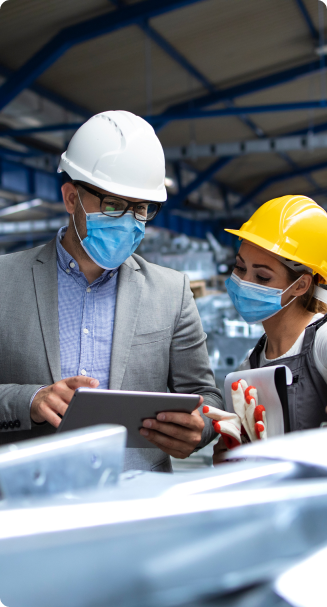Accelerating Software Product Quality In a DevOps Environment

Quality Assurance in the times of Faster Releases
The pandemic has pushed QA transformation across industries into a hyper-accelerated mode.
- Contribute to business growth and outcomes
- Detect defects in software before go-live
- Ensure enhanced user experience and satisfaction
- Protect brand’s image
- Enable all internal teams achieve higher overall quality
How well do Leaders Worldwide think their teams fare while Testing Key Applications?
42%
Think they don’t have enough time for testing
42%
Think they don’t have optimal test automation in place
46%
Think they don’t have the necessary in-house testing environments
55%
Think they don’t have the right testing strategy, process or methodology in place
How Agile and DevOps Changed QA
Unlike the waterfall model of software development, where the testing phase is at the end of the cycle, agile and DevOps models foster continuous testing throughout the SDLC.
Changing Product Testing Approaches
In an agile environment, as we already discussed, creating test cases has as much priority as defining user requirements. When it comes to creating user stories, agile developers also set validation criteria for those requirements, thereby embarking on the testing process from day one.
Testing has moved so far upstream in the SDLC that few of the new strategies have emerged in the agile and DevOps environments.
1. Test-Driven Development (TDD)
This phase usually starts by defining the test case- what actually you want to test, then moves on to writing a user story and concludes with writing a code that fulfills the test case.
2. Acceptance Test-Driven Development (ATDD)
This one is similar to the TDD but it focuses more on user acceptance testing, where the testing is done to verify if the software product works according to the customer’s expectations.
3. Behavior Driven Development (BDD)
The aim of this development is to reach a defined business outcome that helps the developers better understand what features are currently working on.

Changing Testing Strategies
With the fast-paced product deliveries in the Agile and DevOps environments, a well-documented testing plan can be rarely seen. However, as the product quality is not something to be compromised, agile teams have come up with alternate testing strategies to determine the scope, method and objectives of their testing.
Shift left testing is one such strategy that agile teams are following these days. It not only improves the scope of evaluation at early stages but ensures the effective resolution of bugs.

Here are some other non-conventional testing strategies:
1. Operational Testing
It is a type of testing usually done before the production phase. During this, the testing teams if the product, service, or process is secure, stable, and accessible.
The goal of operational testing is to ensure the components of the software are smooth in operation in the standard Operating Environments (SOE).
It focuses mainly on these aspects:
- Resilience
- Recovery
- Integrity
- Manageability
2. Performance Testing
Agile performance testing is a framework, which follows a shift-left philosophy that allows closer evaluation of sprint-level performance.
Here are a few main types of performance testing:
Load Testing: It tests the performance of an application when a large number of users use it at the same time and also checks the response time under various scenarios.
Capacity Testing: In this, the agile teams check if the application can actually take the same traffic as it is designed to without having to compromise on the user experience.
Stress Testing: This refers to checking the performance of the software product under extreme conditions like doubling the number of users, using it with a server having a weak CPU, or with much less memory.
There’s yet another type of testing called security testing where the teams test the software’s ability to withstand attacks and also check the confidentiality, authentication, and integrity concerns. All these tests when performed from the start of SDLC give a comprehensive view of the product quality to the developing teams.
Changes in Testing Execution

Building an Effective QA Plan for a DevOps Environment
Focus on bringing out processes from silos and creating an environment for highly collaborative and iterative efforts
Coordination among the development and testing team from the beginning of the SDLC provides more time for the resolution of bugs. Scenarios requiring timely execution of the software along with sustainability often recommend a shift-left approach. It gets rids of scenarios where executives must go back to the basics, saving a tremendous amount of effort.
1.Keep It Result-Oriented
Agile teams usually work with smaller goals for a specific period of time. QA must also fit into these shorter goals to ensure effective project deliverables. This is easer said, than done. To make your testers and developers work cohesively while also ensuring the deadlines aren’t missed, the plan must make sure they are working towards a common specific outcome.
2. Ensure Transparency
3. Treat Testing As An Ongoing Process Not a Phase
No matter how easy you think the testing process is, you cannot save it up till the end of SDLC. Integrate it within the cycle and throughout the sprint. This helps your agile teams to identify many problems early and fix them right away. Undoubtedly, the quality of the product you develop will never be compromised with this thought process.

Conclusion
In today’s highly-disruptive market, you don’t just have the responsibility to build software, but also you customers’ trust , and do it fast, effective QA makes this possible.
“
Cost is more important than quality, but quality is the best way to reduce cost.
Genichi Taguchi




